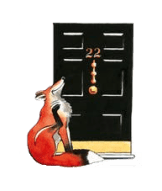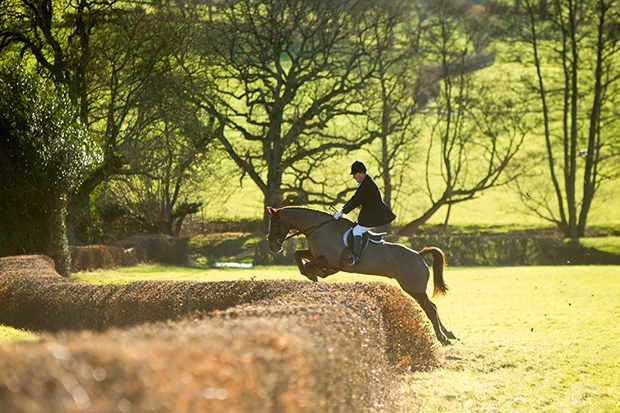In March 2006, I went looking for a hunter in Ireland. In a yard somewhere in Co. Limerick, I tried out a six-year-old bay and a five-year-old liver chestnut. ‘The bay had the better turn of speed,’ I recorded, ‘but was troublesome in the mouth. The build of the liver chestnut was also better. He jumped well… Apparently he won’t do banks, but that doesn’t matter in Sussex. Di was clear that the liver chestnut was the one.’
Di — Diana Grissell, Master of our hunt and carer of any horse I ride — is always right. So I bought the liver chestnut for £5,500. His Irish owner said, ‘He’s got a good lepp on him.’ One is trained not to believe people — especially Irish people — who try to sell one horses, but in this case the man was underselling.
The horse was registered, depressingly, as Smooth Project, but luckily his stable name was Tommy. He was an Irish sport horse, 16.1 hands, middleweight, strongly built — not beautiful, but workmanlike-handsome. He had failed as a showjumper, apparently. He was born to hunt.
At first, Tommy was a bit green and nappy. He could be bossy when put out in the field to graze, and difficult to catch. But from the first he understood the hunting field. The fat creature of summer was transformed for the season. Elegant in his clip, always holding his condition, he was where he wanted to be.
He wanted to be near the front, and would pull until he got there. His only ill temper was against similarly thrusting ponies: he resented being impeded. He always knew when something was happening. When hounds spoke, he would raise his head, swallow his mouthful (he was forever eating), twitch his ears, and move as fast as any non-thoroughbred can manage. He became excited, but like a professional soldier in action, not scared or crazy.
Tommy was what horsey people value above all — ‘genuine’. He was brave, sure-footed, hardy (in ten seasons, he missed only one day because of injury), and he jumped clean — the higher the fence, the neater. When I study the photographs of Tommy jumping, I marvel at how strong are his shoulders and how well-collected his feet. He is carrying his rider with a courteous superiority. He is Jeeves to my Wooster: no matter how fatuous his master, he will get him out of trouble.
If, for example, the rider ahead of me fell on the far side of a hedge, Tommy would spot this quicker than I and take evasive action. He accepted encouragement but not instruction. Once, on the marsh, we approached a metal five-barred gate with a much lower wooden fence beside it. The field master jumped the fence, and I made to follow; but Tommy, noting that it slanted down to an uninviting dyke, disobeyed and jumped the five-barred gate instead, almost from a standstill. None of the field dared come on.
Professional huntsmen, who need a horse that can do anything at any pace, cast covetous eyes on him. Fellow subscribers could not hide their longings. He was like Trollope’s Phineas Finn — an Irish gentleman with fine English ladies making eyes at him.
With complete consistency, Tommy carried me, uninjured, on marsh, down and weald, over timber and ditches, hedges and wire, walls and water. He even got me to the finish of our terrifying hunt scurry. The only bad day we ever had was when we arrived in a trailer (Tommy preferred a box) and he had made himself uncomfortable by thrashing around. He suddenly rolled, throwing me, and when I hit him with my whip to make him stop, he gave me a sharp kick which unfortunately was captured on camera. We went home. But normally I hate to leave before the end, so Tommy often endured six hours beneath me: he never tired.
Last month, we met in hedge country. Our thrusting acting field master led us in a mad career over one we had never jumped from that side. Tommy and I could not see the ditch before, so he stumbled and flattened on the fence. I clung to his neck like a man lying on a surfboard, but still went over his head.
Typically, Tommy was unhurt, let himself be caught, and went on hunting with renewed vigour. We reached a legendary line called Pug’s Hole, where one fords a stream and hurls oneself into space, dropping eight feet over the larger hedges. He leapt them with his special combination of composure and delight, and could not be restrained from galloping on up the hill to where hounds were speaking. Later, we found ourselves back at Pug’s Hole, and our thrusting acting field master tried a repeat. It was all I could do to stop Tommy following, but I was tired and did not want to spoil our earlier perfection.
I am glad we ended thus, because it turned out to be Tommy’s last full day’s hunting. Ten days later, Di rang, on the edge of tears. Tommy had jumped over the wall of his field on to a tarmac road. There he was found grazing, but he was stiff when taken to the stable. Then he lay down and couldn’t move. He had broken his pelvis. The vet put him down. I am glad no one consulted me before this dreadful, necessary deed.
After the shock, I find myself asking how well I knew Tommy. Hardly at all, I think. Horses are not like dogs: they are private, and although I love their company, I have no special gift for them. No doubt Di and Jess, the head stable lad, who both cared for him so well, have a much deeper understanding.
But I do not repine. I did not seek to know his inner being. It was enough to be with him in so many moments of pleasure — and a few of danger — and love and admire him for what he did. I only wish it was easier to thank him — though funnily enough, on that last full day of hunting, I had particularly made much of him.
In the boot rooms of many houses in the country, you will see a popular drawing — a prospect of grass and hedges from the rider’s perspective, framed between his horse’s ears. It is called ‘The finest view in Europe’. That’s what I’ve seen, thanks to Tommy.







Comments